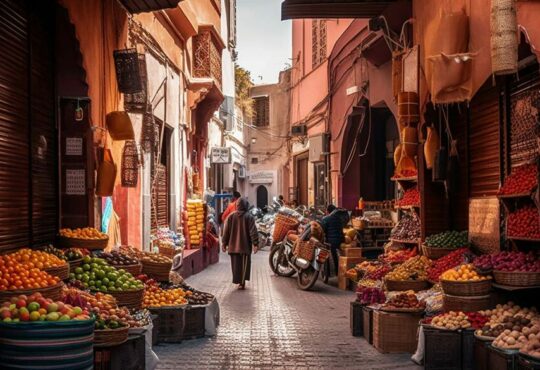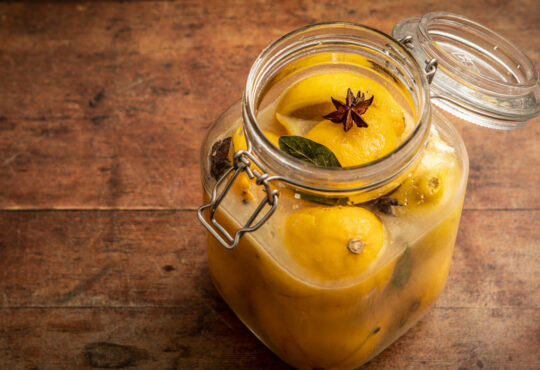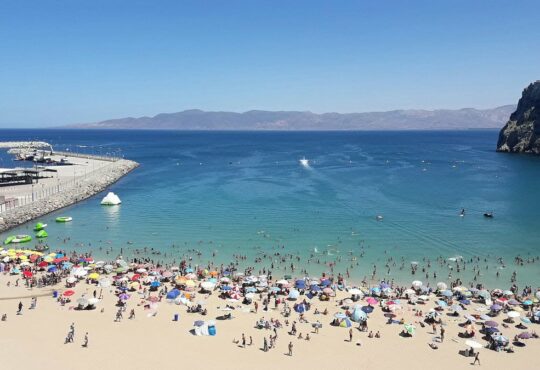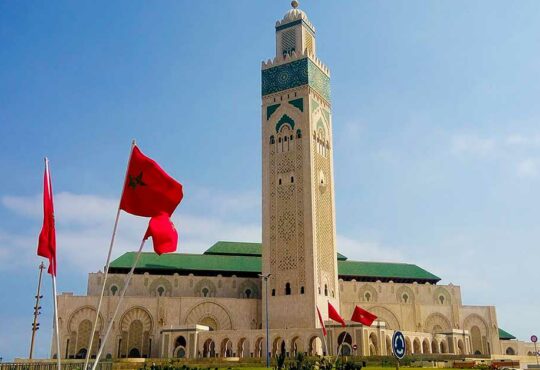472
Here are 100 fascinating facts about Morocco that will amaze and entertain you!
Did you know that Morocco is home to some of the most beautiful architecture in the world? Or that it is one of the most diverse countries in Africa, with a rich culture and history that dates back thousands of years?
In this list of interesting facts about Morocco, you will learn a lot about the country’s geography, history, people, and culture, and if you are visiting Morocco with little ones, here are all the facts about Morocco for kids.
General Facts about Morocco
- Population (2022 census): 37.8 million
- Size: 274,461 square miles
- Capital: Rabat
- Continent: Africa
- Government: Parliamentary constitutional monarchy
- Monarch: Mohammed VI
- Prime Minister (as of 2021): Aziz Akhannouch
- Currency: Moroccan dirham (MAD)
- Language: Moroccan Arabic, French & Berber
- Religion: Islam
Interesting Facts about Morocco
Old walls in Marrakech
- Morocco is a country located in North Africa with the Atlantic Ocean and the Mediterranean Sea to its west and the Sahara Desert to its east.
- Morocco covers an area of approximately 172,410 square miles, making it the 54th largest country in the world.
- The landscape of Morocco is varied, with everything from mountains and forests to deserts and coastline.
- Morocco is only 9 miles from Europe
- The official name of the country is the Kingdom of Morocco.
- The economy of Morocco is based on agriculture, tourism, phosphate mining, and manufacturing.
- The official language of Morocco is Darija (Moroccan Arabic), however, French and Berber are also widely spoken.
- In Morocco, it is customary to greet someone by saying “As-Salamu Alaykum” which means “Peace be upon you”.
- Riads are traditional Moroccan houses or palaces with an inner courtyard. They are often luxurious and expensive places to stay.
- Morocco is a constitutional monarchy with King Mohammed VI as the current monarch who has been reigning since 1999.
Jamaa El Fena in Marrakech
- The government of Morocco is made up of a Prime Minister, who is appointed by the King, and a bicameral parliament.
- The legal system in Morocco is based on French civil law as well as Sharia law.
- The first inhabitants of Morocco were the Berber people. The Phoenicians, Carthaginians, and Romans all conquered the area at different times and left their mark.
- In the seventh century, the Arabs invaded and introduced Islam. The Arabs ruled Morocco until the arrival of the French in 1912.
- Islam makes up the majority religion in Morocco with over 99% of the population practicing. There are also small Jewish minorities.
- Morocco was the first country to recognize the United States of America in 1777.
Essaouira ramparts
- Morocco became a French protectorate in 1912 and gained independence in 1956.
- Morocco is a member of the United Nations, the Arab League, and the African Union.
- The flag of Morocco features a red field with a green pentacle in the center. This symbol is known as the Seal of Solomon and represents the five pillars of Islam.
- The national anthem of Morocco is called “Hymne Chérifien”.
- The largest city in Morocco is Casablanca, which is also the country’s economic capital.
- Marrakech is the second largest city and is a popular tourist destination.
- The climate in Morocco varies depending on the region. The coastal regions have a Mediterranean climate with mild winters and warm summers. The inland regions have a more extreme continental climate with hot summers and cold winters.
Tannerie Chouara in Fes
- Morocco is home to the Atlas Mountains, which are a part of the larger Atlas mountain range that runs through Algeria, Tunisia, and Libya.
- The highest peak in Morocco is Toubkal Mountain, which has an elevation of 13,671 feet.
- There are four major rivers in Morocco: the Sebou, the Moulouya, the Draa, and the Sus.
- Morocco has a diverse range of plant and animal life. Some of the more unique animals that can be found in Morocco include Barbary macaques, Barbary lions, and African wild dogs.
- There are over 12 million sheep in Morocco, making it the country with the seventh largest sheep population in the world.
- Berbers make up around 40% of Morocco’s population
Agadir beach view
- The official religion of Morocco is Islam, however, there is a large population of Christians and Jews as well.
- There are over 400 mosques in Morocco, the most famous being the Hassan II Mosque in Casablanca. Built in 1190, The Koutoubia Mosque is the oldest mosque in Marrakech.
- Some of the popular tourist attractions in Morocco include the Jemaa el-Fnaa, a square, and market in Marrakech; the Medina of Fez, the largest medieval city in the world; and Chefchaouen, a blue-painted city in the Rif Mountains.
- Morocco hosts the largest wind farm in Africa, which is located in the Tarfaya region.
- The life expectancy in Morocco is 72 years for men and 77 years for women.
- The literacy rate in Morocco is 64.
- Some of the traditional dishes in Morocco include couscous, pastilla, and tagine.
- Tea is the national drink of Morocco and is often served with mint and sugar.
- Coffee was actually banned in Morocco for a time in the 16th century
- The national sport of Morocco is football (soccer).
- Some popular Moroccan musicians include Najat Aatabou, Hassan Hakmoun, and Saad Lamjarred.
Ouzoud waterfalls in Beni Mellal
The urban population of Morocco is growing at a rate of about three percent each year.
The birth rate in Morocco is about 17 births per 1000 people.
Morocco has a very young population, with about 30 percent of the population being under the age of 15.
Primary education in Morocco is compulsory and free for all children.
University education in Morocco is tuition-free for Moroccan citizens.
Homeschooling is not allowed in Morocco.
There are over 11 million internet users in Morocco, which is about 45 percent of the population.
Sharif Mohammad al-Idrissi was a Moroccan cartographer who created the Tabula Rogeriana which is considered to be one of the most advanced medieval world maps.
Because of its location, Morocco has been a crossroads for many cultures. The influences of the Berbers, Arabs, Romans, and Europeans are all still evident in Moroccan culture today.
Some of the traditional Berber dances are still performed in Morocco, such as the Aaross and the Ahidus. The Aaross is a dance performed by men, while the Ahidus is a dance performed by women.
Bab Boujloud Gate in Fes
- There are two main types of music in Morocco: folk music and classical music. Moroccan architecture is a mix of Berber, Arab, Andalusian, and Moroccan influences.
- Even though Morocco has gained its independence from the Spanish in 1956, Spain is still occupying two small cities in Morocco: Ceuta and Melilla.
- Earthquakes are not a common occurrence in Morocco, but there have been some notable ones, such as the 1960 Agadir earthquake that killed over 12000 people and more than 500 people in the 2004 Al Hoceima earthquake.
- The Sahara desert covers about three-fifths of Morocco.
- There are nine UNESCO heritage sites in Morocco, such as the Medina of Fez, the Koutoubia Mosque, and many more
- Morocco was the founder member of the African Union but decided to leave in 1984 because of disagreements over the Sahara issue. However, Morocco has rejoined the African Union in 2017.
- Morocco has introduced E-visa for the citizens of 89 countries in 2022. Electronic visas can now be obtained easily from the government website.
- The first woman to lead a political party in Morocco is Touria Ziad.
- Ouarzazate city in Morocco, sometimes called “the door of the desert” is a favorite film shooting location for many Hollywood blockbusters such as Lawrence of Arabia, Gladiator, and Babel.
Moroccan handmade Tagine pots in High Atlas
- Tourism is a major industry in Morocco and it is the country’s second-largest source of foreign income after remittances from Moroccans living abroad.
- The national Animal of Morocco is the Barbary Lion.
- Morocco has been granted a Non-NATO Ally Status by the United States in 2004.
- The national costume of Morocco for men is called a Djellaba and for women, it is called a caftan.
- The national dish of Morocco is Couscous and their national drink is Mint Tea.
- There are many celebrated festivals in Morocco such as the Festival of Roses takes place in Dates Valley.
- It’s very common to see eldest Moroccan Berber women with face tattoos and that’s because, in their culture, it’s a sign of beauty.
- The national Motto of Morocco is “Allah, Al Watan, Al-Malik ” which means “God, Homeland, The King”.
- The national anthem of Morocco is called “Hymne Chérifien
- The oldest inhabited city in Morocco is considered to be Tangier as it was founded by the Phoenicians in the early first millennium BC.
- Hassan II Mosque in Casablanca is the largest mosque in Africa and the third largest in the world.
- Morocco has never won the FIFA World Cup, however, they qualified for the 1986 FIFA World Cup which was held in Mexico.
- Morocco’s land is rich in natural resources such as Phosphates holding 70% of the world’s reserves mostly located in the Sahara.
- The world’s largest solar power plant is located in Ouarzazate, Morocco.
- Argan oil is a unique product that is only found in Morocco. It’s made from the kernels of the argan tree and is used in many cosmetic products.
- Plan Azure is a project that was launched by the Moroccan government in 2009 with the aim of making Morocco carbon-neutral by 2030.
- The Hassan II Bridge connecting Rabat and Salé was, at the time of its completion in 1986, the longest suspended bridge span in the world.
- As of this year (2022), 28 beaches in Morocco are now Blue Flag certified. The Blue Flag Label is awarded to beaches that meet the highest standards of water quality, environmental management, safety, and services.
- Traveling to Morocco during Ramadan can be very different from what you would expect as the country comes to life only at night during this holy month. During the day, most businesses and restaurants are closed but come alive after sunset when people break their fast.
Moroccan spices
- Africa’s highest ski resort is located in Oukaïmeden, Morocco.
- Ibn Battuta is a famous medieval Moroccan explorer, who traveled more than 75,000 miles, making him one of the most well-traveled people of his time.
- There is a Blue City in Morocco, called Chefchaouen
- There is also a Red City and it’s known as Marrakech
- Snake charmers are a real thing in Morocco
- There is a ski resort in Morocco
- The largest active medina in the world is located in Fes
- Homosexuality is illegal in Morocco
- The oldest human sculpture is found in Morocco and named the Venus of Tan Tan. It was discovered in 1999 and it’s believed to date back 500,000 years ago.
- The Sahara desert covers over 85% of Morocco
Funny facts about Morocco
- One of the really fun facts about Morocco is that the symbol of love is actually the Liver and not the heart.
- Something that all Moroccans know and do (myself included) is when eating a meat Tagine with vegetables (a famous dish in Morocco), meat is only eaten at the end not in the beginning, not in the middle at the END.
- Sugarloaves are still produced and very popular in Morocco. Also, it is commonly offered as a gift for sad and happy occasions.
- Did we miss anything? Let us know in the comments below if you have any facts about Morocco that you think should be on this list.
- We hope you found this list of Morocco facts informative and that it gave you a better understanding of this North African country.
- If you’re planning a trip to Morocco anytime soon, be sure to keep checking our travel Morocco travel guides. Happy travels!
SAVE THIS ON PINTEREST!
Share FacebookTwitterPinterestWhatsapp
Fatima was born and raised along the foothills of the Atlas mountains in central Morocco, in the heartland of the indigenous Amazigh peoples. She’s an avid reader and Moroccan tea drinker, no surprise. She is an engineer by profession but nowadays spends most of her time traveling and writing about Morocco.





